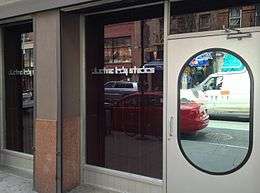Electric Lady Studios
|
Front entrance in New York City in April 2013 | |
| Address | 52 West Eighth Street, Greenwich Village, New York City 10011 |
|---|---|
| Coordinates | 40°43′59″N 73°59′56″W / 40.73306°N 73.99889°WCoordinates: 40°43′59″N 73°59′56″W / 40.73306°N 73.99889°W |
| Opened | August 26, 1970 |
Electric Lady Studios is a recording studio located at 52 West Eighth Street in Greenwich Village, New York City. It was originally built by Jimi Hendrix and designed by John Storyk in 1970. Hendrix spent only four weeks recording in Electric Lady before his death, but it has since been used by many notable artists; see below list of artists recorded.
History
Electric Lady Studio's current address has a long history. The basement housed The Village Barn nightclub from 1930 to 1967. Abstract expressionist artist Hans Hofmann began lecturing there in 1938, eventually retiring from teaching in 1958 to paint full-time.
In 1968, Jimi Hendrix and his manager Michael Jeffery bought a newly defunct nightclub called The Generation located at 52 W 8th Street in New York's Greenwich Village — a venue that Hendrix had frequented for impromptu performances and late-night jam sessions. The Generation had been known for live acts as diverse and legendary as Big Brother & the Holding Company, B.B. King, Chuck Berry, Dave Van Ronk, Sly & the Family Stone, and John Fahey. Instead of renaming the club and continuing with the live venue business model (Jimi's original vision for the project), advisors Eddie Kramer and Jim Marron convinced Hendrix to convert the space into a professional recording studio, as studio fees for the lengthy Electric Ladyland sessions were astronomical, and Jimi was constantly in search of a recording environment that suited him. Architect and acoustician John Storyk designed each structural detail, and from there the origins of New York's famed Electric Lady Studios were born. It was the only artist-owned recording studio in existence at the time.

Construction of the studio took nearly double the amount of time and money as planned: permits were delayed numerous times, the site flooded due to heavy rains during demolition, and sump pumps had to be installed (then soundproofed) after it was determined that the building sat on the tributary of an underground river, Minetta Creek.[1] A six-figure loan from Warner Brothers was required to save the project.
The studio was made specifically for Hendrix, with round windows and a machine capable of generating ambient lighting in myriad colors. It was designed to have a relaxing feel to encourage Jimi's creativity, but at the same time provide a professional recording atmosphere. Engineer Kramer upheld this by refusing to allow any drug use during session work. Artist Lance Jost painted the studio in a psychedelic space theme.[2] Jimi Hendrix hired Marron to manage the construction project and run the studio. Hendrix spent only four weeks recording in Electric Lady, most of which took place while the final phases of construction were still ongoing. An opening party was held on August 26, 1970. The following day Hendrix created his last ever studio recording: a cool and tranquil instrumental known only as "Slow Blues". He then boarded an Air India flight for London to perform at the Isle of Wight Festival, and died less than three weeks later.
Onwards into the following three decades, Electric Lady was used to record albums by the likes of Stevie Wonder, David Bowie, AC/DC, The Clash, and Weezer. The start of the 2000's saw the studio acting as a home to the Soulquarians, but soon Electric Lady faced a period of financial hardship.[3] By 2010, the studio was taken over by investor Keith Stoltz and studio manager Lee Foster, under whose leadership saw the studio hosting sessions by the likes of Adele, Kanye West, and Daft Punk.[4] Electric Lady was renovated and expanded, with a new mixing studio added to the second floor and the third turned into a self-contained united including Studio C, a private lounge, and another mix suite.[5]
List of artists recorded
Following is a list of some notable artists who recorded at Electric Lady Studios. [6]
- The War on Drugs
- Chic
- Foreigner
- Dave Matthews Band
- Erykah Badu
- Mew
- The Roots
- Bob Dylan
- John Lennon
- Larry Coryell
- Ric Ocasek
- Kiss
- Van Halen
- Arcade Fire
- David Bowie
- The Clash
- AC/DC
- Guns N' Roses
- Ryan Adams
- John Mayer
- Michael Stanley Band
- The Strokes
- Daryl Hall & John Oates
- U2
- Gwen Stefani
- Blake Shelton
- Daft Punk
- Fleet Foxes
- Weezer
- Christina Aguilera
- A-ha
- D'Angelo
- Dan Auerbach
- Lana Del Rey
- Charly García
- Sara Bareilles
- Lady Gaga
- Stevie Wonder
- Led Zeppelin
- The Rolling Stones
- Billy Idol
- Santana
- Beck
- Kanye West
- J. Cole
- Frank Ocean
- Prince
- Blondie
- Residente[7]
- Adam Levine
See also
- Albums recorded at Electric Lady Studios
References
- ↑ Chris Potash, The Jimi Hendrix Companion: Three Decades of Commentary (New York: Schirmer Books, 1996), p. 94.
- ↑ "Lance Jost Designs Vintage Paintings". Retrieved April 9, 2007.
- ↑ "The Believer - A River Runs Through It". The Believer. 2015-01-01. Retrieved 2017-08-07.
- ↑ Schillinger, Liesl (2015-08-12). "Jimi Hendrix’s Electric Lady Studios Turns 45". Wall Street Journal. ISSN 0099-9660. Retrieved 2017-08-07.
- ↑ "A Classic Now More Classic: Electric Lady Studios Expands, Adds Neve, API Consoles". SonicScoop. 2011-07-11. Retrieved 2017-08-07.
- ↑ Schillinger, Liesl. "Jimi Hendrix's Electric Lady Studios Turns 45." WSJ. Wsj.com, August 12, 2015. Accessed October 18, 2016.
- ↑ Pareles, Jon (20 January 2017). "Residente Chases His Muse, at the Genetic Level". The New York Times. The New York Times Company. Retrieved April 11, 2017.
External links
| Wikimedia Commons has media related to Electric Lady Studios. |
